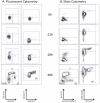Single-cell mass cytometry adapted to measurements of the cell cycle
- PMID: 22693166
- PMCID: PMC3667754
- DOI: 10.1002/cyto.a.22075
Single-cell mass cytometry adapted to measurements of the cell cycle
Abstract
Mass cytometry is a recently introduced technology that utilizes transition element isotope-tagged antibodies for protein detection on a single-cell basis. By circumventing the limitations of emission spectral overlap associated with fluorochromes utilized in traditional flow cytometry, mass cytometry currently allows measurement of up to 40 parameters per cell. Recently, a comprehensive mass cytometry analysis was described for the hematopoietic differentiation program in human bone marrow from a healthy donor. The current study describes approaches to delineate cell cycle stages utilizing 5-iodo-2-deoxyuridine (IdU) to mark cells in S phase, simultaneously with antibodies against cyclin B1, cyclin A, and phosphorylated histone H3 (S28) that characterize the other cell cycle phases. Protocols were developed in which an antibody against phosphorylated retinoblastoma protein (Rb) at serines 807 and 811 was used to separate cells in G0 and G1 phases of the cell cycle. This mass cytometry method yielded cell cycle distributions of both normal and cancer cell populations that were equivalent to those obtained by traditional fluorescence cytometry techniques. We applied this to map the cell cycle phases of cells spanning the hematopoietic hierarchy in healthy human bone marrow as a prelude to later studies with cancers and other disorders of this lineage.
Copyright © 2012 International Society for Advancement of Cytometry.
Figures














Comment in
-
Cycling into future: mass cytometry for the cell-cycle analysis.Cytometry A. 2012 Jul;81(7):546-8. doi: 10.1002/cyto.a.22080. Epub 2012 Jun 12. Cytometry A. 2012. PMID: 22692796 Free PMC article. No abstract available.
References
-
- Ornatsky O, Baranov VI, Bandura DR, Tanner SD, Dick J. Multiple cellular antigen detection by ICP-MS. J Immunol Methods. 2006 Jan 20;308:68. - PubMed
-
- Bandura DR, et al. Mass cytometry: technique for real time single cell multitarget immunoassay based on inductively coupled plasma time-of-flight mass spectrometry. Anal Chem. 2009 Aug 15;81:6813. - PubMed
Publication types
MeSH terms
Substances
Grants and funding
LinkOut - more resources
Full Text Sources
Other Literature Sources
Miscellaneous

